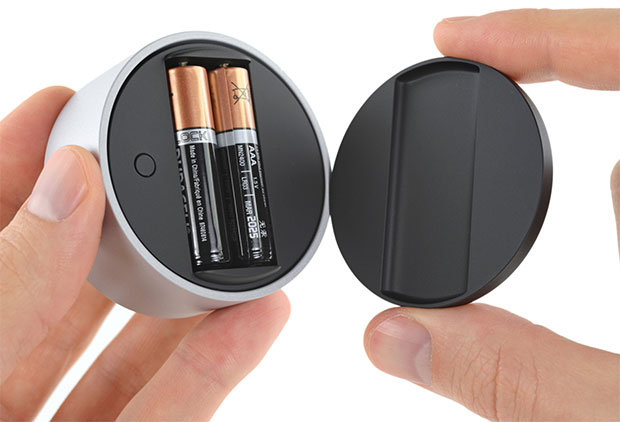Microsoft Surface Dial Teardown Shows Intricate Guts And Tough Repairability
We saw in a teardown analysis earlier this week how difficult it is to perform at-home repairs and upgrades on Microsoft's recently announced Surface Studio all-in-one desktop, which comes with several core components soldered to the motherboard, but what about the hockey puck shaped Surface Dial accessory that goes along with it? Don't hold your breath hoping that it's any less difficult to work on.

About the only thing that can be done on the Surface Dial without a bucket of courage and years of experience is swap out the pair of AAA batteries as needed. The rubber bottom protecting the battery compartment is held on with magnets and pops off with ease—there's no annoying adhesive holding it in place or even plastic clips that can sometimes to be a nuisance.
Digging any deeper presents a challenge. The experienced repair folks at iFixIt described in their teardown log how difficult it was popping the mid-frame out of the Surface Dial chassis, which required the use of a metal spudger.
"Some aggressive prying led to aggressive snapping which led to aggressive... well, let's just say the mid-frame didn't come out without a fight," the repair gurus noted.

Four evenly placed magnets can be seen underneath the mid-frame. They're the same ones that pull and hold the cover in place, as well as give the Surface Dial added grip to the Surface Studio's display. With the mid-frame removed, the interior electronics come into sight. This is also where things get decidedly more tricky.
The board inside the Surface Dial spins but doesn't pop out. Ah, but there's a trick. There's a single access hole that needs to be lined up with each of the T6 screws holding the body to the silver cover. Once those are removed, the guts start to spill out from the outer casing.

There are still pieces to disassemble at that point, at least for a full teardown, and it takes some patience and a steady hand. However, most people probably won't get that far. For one, the components most likely to fail can't be replaced without likely damaging the device. And if the haptic motor goes out, it's a tough swap—it's "cemented down with some spectacularly tough glue."
For those reasons and more, the Surface Dial earned itself a mediocre 4 out 10 Repairability Score.

About the only thing that can be done on the Surface Dial without a bucket of courage and years of experience is swap out the pair of AAA batteries as needed. The rubber bottom protecting the battery compartment is held on with magnets and pops off with ease—there's no annoying adhesive holding it in place or even plastic clips that can sometimes to be a nuisance.
Digging any deeper presents a challenge. The experienced repair folks at iFixIt described in their teardown log how difficult it was popping the mid-frame out of the Surface Dial chassis, which required the use of a metal spudger.
"Some aggressive prying led to aggressive snapping which led to aggressive... well, let's just say the mid-frame didn't come out without a fight," the repair gurus noted.

Four evenly placed magnets can be seen underneath the mid-frame. They're the same ones that pull and hold the cover in place, as well as give the Surface Dial added grip to the Surface Studio's display. With the mid-frame removed, the interior electronics come into sight. This is also where things get decidedly more tricky.
The board inside the Surface Dial spins but doesn't pop out. Ah, but there's a trick. There's a single access hole that needs to be lined up with each of the T6 screws holding the body to the silver cover. Once those are removed, the guts start to spill out from the outer casing.

There are still pieces to disassemble at that point, at least for a full teardown, and it takes some patience and a steady hand. However, most people probably won't get that far. For one, the components most likely to fail can't be replaced without likely damaging the device. And if the haptic motor goes out, it's a tough swap—it's "cemented down with some spectacularly tough glue."
For those reasons and more, the Surface Dial earned itself a mediocre 4 out 10 Repairability Score.

